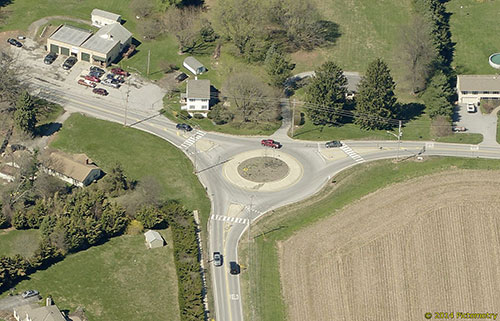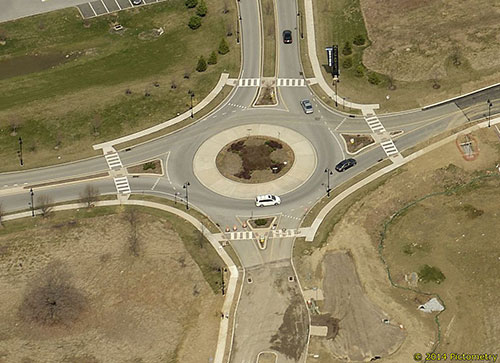Roundabouts
Roundabouts
Roundabouts are a subset of circular intersections with specific design and traffic control features. These features include yield control of all entering traffic, channelized approaches, and geometric curvature and features to induce desirable vehicular speeds. (Roundabouts: An Informational Guide, Second Edition, 2010, Transportation Research Board, p.1-4)
Standards
PennDOT: Follow the recommendations contained in the Transportation Research Board's National Cooperative Highway Research Program (NCHRP) Report 672: Roundabouts: An Informational Guide.
Comments
Roundabouts reduce traffic conflicts (for example, left turns) that are frequent causes of crashes at traditional intersections. Unlike a traffic circle or a rotary, a roundabout's incoming traffic yields to the circulating traffic. (FHWA)
The following is an excerpt from the Federal Highway Administration's Technical Summary on Roundabouts (FHWA-SA-10-006) regarding the benefits of roundabouts:
Roundabouts are becoming more popular based on the multiple opportunities to improve safety and operational efficiency, and provide other benefits. Of course, roundabouts are not always feasible and do not always provide the optimal solution for every problem. The benefits of roundabout intersections, and some constraining factors, are described below.

Existing Roundabout in Unionville, Chester County.
- Traffic Safety — Numerous studies have shown significant safety improvements at intersections converted from conventional forms to roundabouts. The physical shape of roundabouts eliminate crossing conflicts that are present at conventional intersections, thus reducing the total number of potential conflict points and the most severe of those conflict points. The most comprehensive and recent study showed overall reductions of 35 percent in total crashes and 76 percent in injury crashes [4]. Severe, incapacitating injuries and fatalities are rare, with one study reporting 89-percent reduction in these types of crashes [5] and another reporting 100-percent reduction in fatalities [6].
- Operational Performance — When operating within their capacity, roundabouts typically have lower overall delay than signalized and all-way stop-controlled intersections. The delay reduction is often most significant during non-peak traffic periods. These performance benefits can often result in reduced lane requirements between intersections. When used at the terminals of freeway interchanges, roundabouts can often reduce lane requirements for bridges over or under the freeway, thus substantially reducing construction costs. However, as yield-controlled intersections, roundabouts do not provide priority to specific users such as trains, transit, or emergency vehicles.
- Environmental Factors — Roundabouts often provide environmental benefits by reducing vehicle delay and the number and duration of stops compared with signalized or all-way stop-controlled alternatives. Even when there are heavy volumes, vehicles continue to advance slowly in moving queues rather than coming to a complete stop. This can reduce noise and air quality impacts and fuel consumption significantly by reducing the number of acceleration/deceleration cycles and the time spent idling.
- Access Management — Because roundabouts can facilitate U-turns, they can be a key element of a comprehensive access management strategy to reduce or eliminate left-turn movements at driveways between major intersections.
- Traffic Calming — Roundabouts can have traffic calming effects on streets by reducing vehicle speeds using geometric design rather than relying solely on traffic control devices.
- Pedestrian Safety — Due to the reduction of vehicle speeds in and around the intersection, roundabouts can improve pedestrian crossing opportunities. Additionally, the splitter island refuge area provides the ability for pedestrians to focus on one traffic stream at a time while crossing. However, pedestrians with visual impairments may not receive the same level of information at a roundabout as at a typical signalized intersection, and they may require additional treatments, such as pedestrian signalization. Specific design treatments for enhancing accessibility for visually impaired pedestrians are receiving continued study [7].
- Aesthetics — The central island and splitter islands offer the opportunity to provide attractive entries or centerpieces to communities through use of landscaping, monuments, and art, provided that they are appropriate for the speed environment in which the roundabout is located.
- Land Use — Roundabouts can provide a transition area between high-speed rural and low-speed urban environments. They can also be used to demarcate commercial areas from residential areas.
- Ongoing Operations and Maintenance — A roundabout typically has lower operating and maintenance costs than a traffic signal due to the lack of technical hardware, signal timing equipment, and electricity needs. Roundabouts also provide substantial cost savings to society due to the reduction in crashes, particularly fatal and injury crashes, over their service life. As a result, the overall life cycle costs of a roundabout can be significantly less than that of a signalized intersection.
- Approach Roadway Width — A roundabout may reduce the amount of widening needed on the approach roadways in comparison to alternative intersection forms. While signalized or stop-controlled intersections can require adding lengthy left-turn and/or right-turn lanes, a roundabout may enable maintaining a narrower cross section in advance of the intersection. However, roundabouts usually require more space for the circulatory roadway, central island, and sidewalks than the typically rectangular space inside traditional intersections. Therefore, roundabouts often have greater right-of-way needs at the intersection quadrants compared with other intersection forms.
The following table (Exhibit 1-9: Roundabout Category Comparison from the National Cooperative Highway Research Program (NCHRP) Report 672: Roundabouts: An Informational Guide — page 1-12) summarizes the basic geometry and capacities of roundabouts to provide for a quick assessment on the applicability of a roundabout for any proposed location.
| Design Element | Mini-Roundabout | Single-Lane Roundabout | Multilane Roundabout |
|---|---|---|---|
| Desirable maximum entry design speed | 15 to 20 mph (25 to 30 km/h) |
20 to 25 mph (30 to 40 km/h) |
25 to 30 mph (40 to 50 km/h) |
| Maximum number of entering lanes per approach | 1 | 1 | 2+ |
| Typical inscribed circle diameter | 45 to 90 ft (13 to 27 m) |
90 to 180 ft (27 to 55 m)) |
150 to 300 ft (46 to 91 m) |
| Central island treatment | Fully traversable | Raised (may have traversable apron) | Raised (may have traversable apron) |
| Typical daily service volumes on 4-leg roundabout below which may be expected to operate without requiring a detailed capacity analysis (veh/day)* | Up to approximately 15,000 | Up to approximately 25,000 | Up to approximatly 45,000 for two-lane roundabout |
*Operational analysis needed to verify upper limit for specific applications or for roundabouts with more than two lanes or four legs.
Recommendations
- Refer to PennDOT's Roundabout Website for the latest guidance regarding roundabouts.
- Follow the recommendations contained in the Transportation Research Board's National Cooperative Highway Research Program (NCHRP) Report 672: Roundabouts: An Informational Guide.

Roundabout in the Uptown Worthington development in East Whiteland Township, Chester County, PA.


